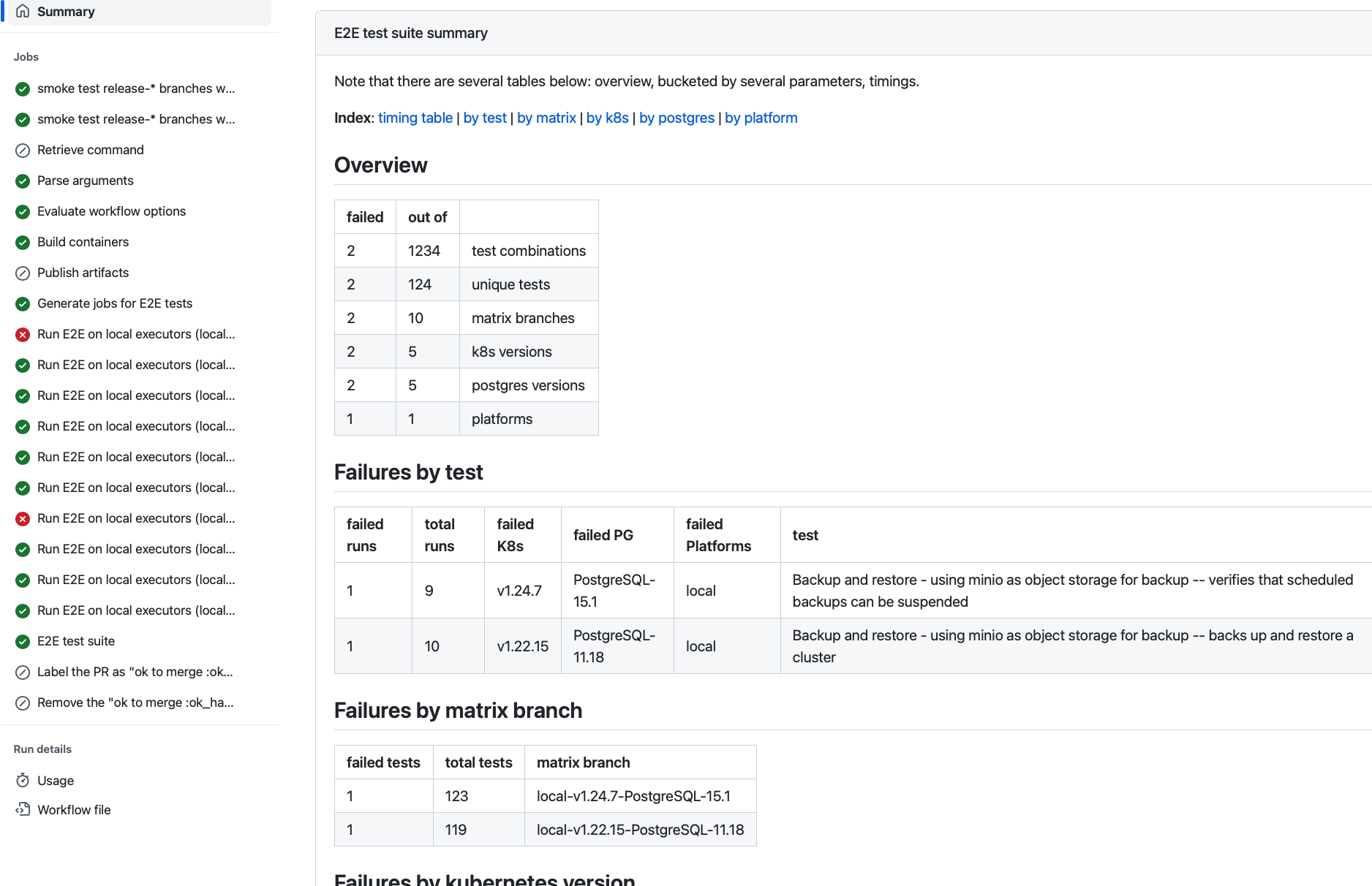Introducing Ciclops, a new GitHub action to better understand CI/CD test results

January 25, 2023 • 5 minutes

At CloudNativePG we take testing seriously; particularly end-to-end testing. The CloudNativePG operator needs to work across different versions of Kubernetes and PostgreSQL. We have an extensive test suite (over 100 end-to-end tests) that we run on several combinations of versions of Postgres and Kubernetes, as part of our Continuous Integration pipeline.
The goal of all this testing is to enhance the continuous delivery posture of our software, by building quality directly into the product. Such tests indeed ensure that new features developed in separate branches do not introduce any regression, as we need them to pass before we merge the commit on the trunk. Moreover, each new patch should enrich the tests of sets. This is what enables continuous delivery, and at the same time allows us to say that the latest snapshot on main is the best version of CloudNativePG so far. Ever.
We are using GitHub Actions in our github repository, and a
strategy: matrix
handles generating jobs for each combination of versions of Kubernetes and
Postgres we want to run the test suite on.
This can blow up quickly. In the image below, you can see a matrix with 9 branches, five of which have errors in the End-to-End Test suite.

Without going into each branch to investigate which tests fail, we don’t know if there is a pattern to the failures. Did the same tests fail on all the branches? On branches with failures, are there many failed tests, or few? Are there any noteworthy patterns to the failures?
Investigating test failures becomes a time sink. And 9 branches are not even that much; internally at EDB we test more combinations, including the different cloud providers, for our EDB Postgres for Kubernetes operator. It is not uncommon for us to have on the order of 80 matrix branches.
With this much data volume, information gets lost … like … tears in rain.
At EDB we developed a system using a GitHub App that ingested test data into an Elastic database, connected to a Grafana dashboard. This enabled us to get a quick overview of failures in CI test runs.
But this system was not free, and therefore could not be made available to the CloudNativePG community. We sorely missed having the functionality available.
CIclops
We decided to take the spirit of our CI test suite scanner, and the new tool
ciclops was born.
CIclops (ciclops, pronounced either cyclops or “see I clops”) provides an intelligible overview of the test executions in a single run of our CI pipeline. It does so by taking as input JSON artifacts for each test executed, on each branch in a given CI run. It computes a summary based on classifying failures into several buckets of interest, and displays it as a GitHub Job Summary:

In the example above, we see at a glance that two matrix branches have failures,
but only two tests have failed in the whole suite (2 test combinations out of
12340). The failed tests affect two versions of Kubernetes and two versions of
PostgreSQL.
Right away we can start getting an idea. Perhaps, in this case, we could
conclude that the Backup and restore tests are showing a bit of brittleness.
We might try again with laxer timeouts in some of the test assertions. But we
could also conclude that the tests are mostly in good shape.
CIclops is available with the same open-source license and collaboration model as CloudNativePG. This is the repository. Feel free to use it, fork it, and contribute to it!
Technical details
CIclops is a GitHub Action, built with Python and deployed using a Docker image. The documentation contains explanations on building the GitHub Action, so it might serve as a good tutorial if you want to build your own Docker-based GitHub Action.
While the development of CIclops has been guided by our use case of testing a Kubernetes operator for PostgreSQL databases, the model is usable more generally to:
- get the test execution in each matrix branch to produce a JSON report with the results
- transform the JSON reports produced previously into a series of JSON files, one per test run, with a normalized schema (details below)
- have a step in the CI pipeline to collect all the normalized JSON files produced in all the matrix branches, and place them all in a single directory
- invoke
ciclopspassing the location of the directory produced in the previous step
This is the normalized schema CIclops expects for the input files:
{
"name": "InitDB settings - custom default locale -- use the custom default locale specified",
"state": "passed",
"start_time": "2021-11-29T18:29:12.613387+01:00",
"end_time": "2021-11-29T18:31:07.988145+01:00",
"error": "",
"error_file": "",
"error_line": 0,
"platform": "local",
"postgres_kind": "PostgreSQL",
"matrix_id": "id1",
"postgres_version": "11.1",
"k8s_version": "22",
"workflow_id": 12,
"repo": "my-repo",
"branch": "my-branch"
}
As you can see, there are fields to describe the test failure, but also fields to describe the versions of PostgreSQL and Kubernetes where the test failure happened.
The project README.md file contains instructions on using ciclops as part of
your GithHub workflow. In addition, the CloudNativePG operator’s
continuous delivery workflow,
which uses ciclops, should serve as a live example.
We hope the project can serve you either directly, or as a starting point to your own forks. We would be happy to hear of suggestions for improvement, and even happier to receive pull requests. Enjoy!
Categories in this blog post
All categories
- Alerts
- Applications
- Benchmarks
- Blog
- Chaos-Engineering
- Cloudnativepg
- Cncf
- Cnpg
- Community
- Containers
- Continuous-Delivery
- Continuous-Integration
- Dashboards
- Dba
- Debian
- Devops
- Failover
- Github
- Grafana
- Graphql
- Hasura
- Helm
- Imagecatalog
- Images
- Information
- K8s
- Kubernetes
- Lfx
- Linux
- Mentorship
- Migrations
- Minecraft
- Open-Source
- Operator
- Pdb
- Performance
- Pg16beta1
- Pgbouncer
- PgTAP
- PGXN
- Pooler
- Postgres
- Postgresql
- Preview
- Programming
- Prometheus
- Release
- Ruby
- Service-Mesh
- Spotlight
- Sqitch
- Tablespaces
- Testing
- Tutorial
- UX
- Volumesnapshots
Latest Posts

Jonathan Gonzalez V.






